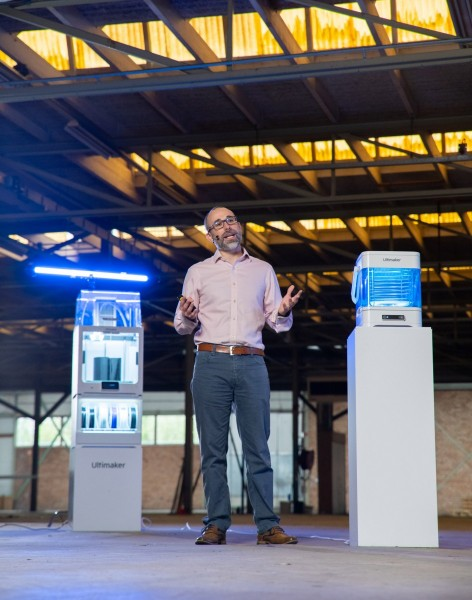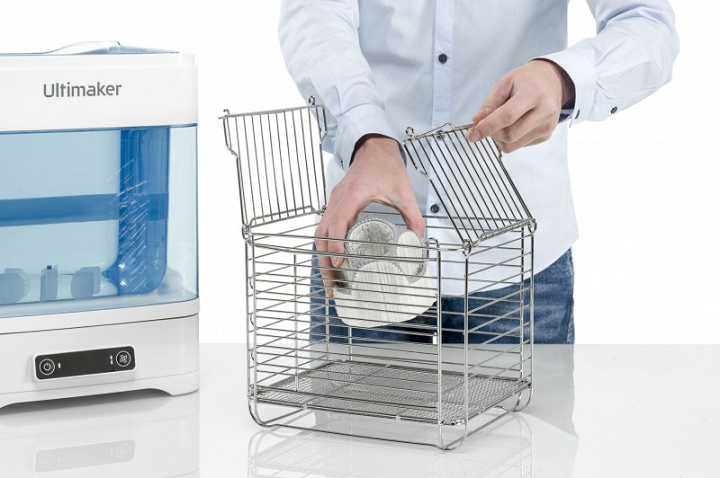Recently, Ultimaker held its inaugural Showcase event, which is a new biannual platform for the company to share all of its latest news in order to show how innovation will be a core strategic pillar going forward. In addition to new materials and new software and firmware features and updates, the best news was saved for last, when CTO Miguel Calvo announced the new Ultimaker PVA Removal Station near the end of the Showcase.
“Feedback from our users is that the removal of PVA is time-consuming and certainly not hassle-free,” Calvo said during the Showcase. “Ultimaker has been working hard on a solution to these problems, and today I’m delighted to announce the Ultimaker PVA Removal Station, bringing efficient post-processing with peace of mind.”
The addition of the professional PVA Removal Station to the Ultimaker Platform will help users develop their products, and bring them to market, much more quickly, as it ensures fast and effective post-processing of prints that use PVA support material. Currently in the final stages of development, Ultimaker claims that its PVA Removal Station makes post-processing four times faster than normal.
“Ultimaker is always looking for ways to remove barriers to 3D printing. To make things easier, remove complexity, give users the reassurance of a successful print. We know that organizations are challenged to bring more complex products to market faster,” said Jürgen von Hollen, CEO at Ultimaker. “Our new professional PVA Removal Station is the missing link in our end-to-end solution platform, helping designers, engineers, architects, and educators to drive in-house innovation. Our entire 3D printing platform, now including the PVA Removal Station, will allow them to speed up the prototyping and product development processes, enabling safe, quick, and effective PVA removal from even the most complex designs and geometries. It allows teams to visualise quicker approval processes so organizations can run smoother and be smarter.”
When you print parts that require support material, some post-processing is required. Plastic supports typically snap off pretty easily, though sometimes you need to get pliers involved, but PVA, or PolyVinyl Alcohol, is a different story. While it’s a very hands-off solution in terms of the actual post-processing, it takes a long time to dissolve this water-soluble support material, which typically occurs by letting the printed part soak in water for a long time.
Depending on how big your part is, how dense the support structure is, and the complexity of the design, it can take over a day to fully dissolve PVA supports; I can attest to this personally, having used PVA support materials during my review of the Ultimaker S5. I definitely appreciate the ease of just dropping a part into a container of water, walking away, and letting the supports dissolve, but the gummy feel afterward is kind of gross, and having to wait that long for clean parts isn’t great either.
Ultimaker says that its PVA Removal Station is able to reduce the time it takes to dissolve PVA supports by up to 75%, and also decreases the operating time since users don’t have to check on the dissolving process or manually remove the PVA. Simply put your part in the basket, fill the station with water, push the start button, and go about your business. Three to four hours later, all the PVA will be gone from your finished print, and you won’t have to mess with any of that sticky residue.
The Ultimaker PVA Removal Station fills with 13.5 liters of water for dissolving the support material and sounds super easy to use, as the circulation direction changes automatically and you can adjust the speed on your own should you want. The station includes an internal basket, complete with dividers to keep the prints in place and submerged during the dissolve process. The container is transparent so you can take a peek and see how things are progressing, and a saturation indicator lets you know if the water needs to be changed, so it’s easy to clean and maintain as well.
Ultimaker’s new PVA Removal Station is slated to be available for purchase in the first half of 2022.
Subscribe to Our Email Newsletter
Stay up-to-date on all the latest news from the 3D printing industry and receive information and offers from third party vendors.
You May Also Like
Further Understanding of 3D Printing Design at ADDITIV Design World
ADDITIV is back once again! This time, the virtual platform for additive manufacturing will be holding the first-ever edition of ADDITIV Design World on May 23rd from 9:00 AM –...
3D Printer Maker EVO-tech Reborn as NEVO3D — Once More With Feeling
EVO-tech was a 3D printing service and original equipment manufacturer established in 2013 and based in Schörfling am Attersee, Austria. The company produced high-quality material extrusion systems featuring linear bearings,...
3D Systems Brings 3D Printed PEEK Cranial Implant to the U.S. with FDA Clearance
For more than 10 years, 3D Systems (NYSE:DDD) has worked hand-in-hand with surgeons to plan over 150,000 patient-specific cases, and develop more than two million instruments and implants from its...
CDFAM Returns to Berlin for Second Annual Symposium
The second CDFAM Computational Design Symposium is scheduled for May 7-8, 2024, in Berlin, and will convene leading experts in computational design across all scales. Building upon the first event...



































